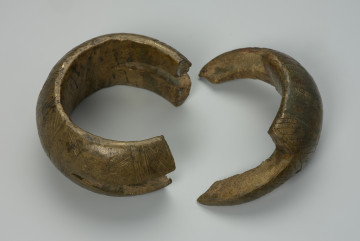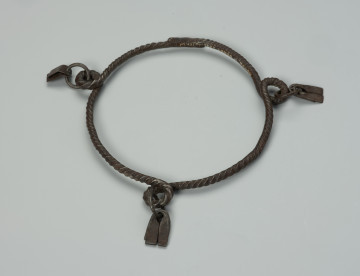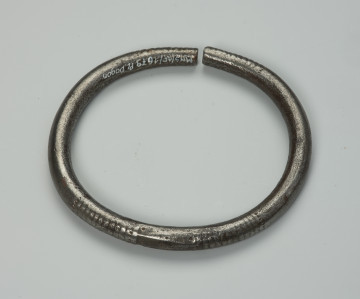
Women's anklet
między 1940 — 1950
National Museum in Szczecin
Part of the collection: Collection of Dogonian art
The sickle carved from iron has a wooden handle in the form of a figure with breasts and a beard, representing a hermaphrodite ancestor. The Dogon believe that the first pair of people who gave birth to eight ancestors - four male and four female - was created by Amma, the creator god. These ancestors were given a special gift; they were hermaphrodites and could impregnate themselves. According to Dogon mythology, they populated the entire earth, giving birth to eighty descendants. The sickle was made by a blacksmith, also considered the ‘master of wood’ by the Dogon. The blacksmith holds a special place in Dogon mythology. According to the myth, he came down to earth from heaven and brought the first people cereal grains and daba - iron hoes, with which they became farmers. In addition, he stole a piece of the sun to light the first fire to make the necessary tools and weapons for the people. The Dogon believe that modern blacksmiths are descendants of the mythical ancestor, who completed the role of the god Amma by teaching the people how to farm and spreading tools among them.The Dogon are an agricultural people, cultivating, among others, millet, sorghum, fonio (Digitaria exilis), rice, sesame, beans, corn, sorrel, peanuts and shallots. The latter is the most popular export product. It is broken into pulp, formed into balls, dried on the terraces of houses, and sold at markets. All healthy family members carry out cultivation of the land. The heavier work is done by men and the stronger women, while older people and children do the lighter work. Intensive farming begins in June with the sowing of millet and ends in March with the harvesting of onions. Rice and fonio are cut with a sickle, then brought to the homestead and stored in the ears, threshed as needed. The Dogon believe that millet, fonio and rice were the first plants their ancestors planted.
Katarzyna Findlik-Gawron
Author / creator
Dimensions
cały obiekt: height: 37,5 cm, width: 17,5 cm
Object type
agricultural equipment
Creation time / dating
Creation / finding place
Identification number
Location / status

między 1940 — 1950
National Museum in Szczecin

około 1940
National Museum in Szczecin

około 1940
National Museum in Szczecin
DISCOVER this TOPIC
National Museum in Lublin
DISCOVER this PATH
Educational path